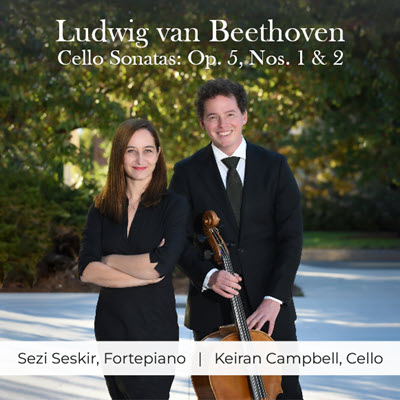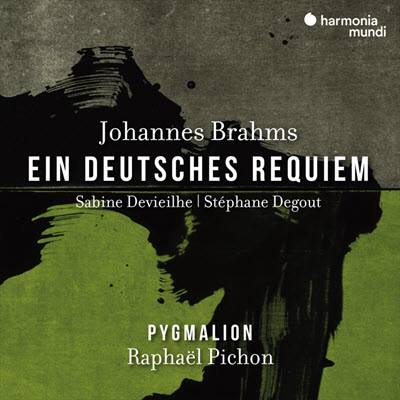by Steven Silverman
Published November 10, 2025
Ludwig van Beethoven: Cello Sonatas, Op. 5, Nos. 1 & 2. Fortepianist Sezi Seskir and cellist Keiran Campbell. Leaf Music, 2025

Beethoven’s Sonatas for Piano and Cello, his Op. 5, created a new genre: a modern sonata where the cello no longer just reinforces the bass, but becomes an equal — or, in the case of Op. 5, nearly equal — participant.
Beethoven composed the two sonatas, No. 1 in F Major and No. 2 in G minor, in 1796 while on tour in Prussia. There the composer had the good fortune to meet the Prussian court’s resident virtuoso cellist, Jean-Louis Duport, who schooled Beethoven in the instrument’s possibilities. Thus, in Op. 5, the cello uses all of its registers, plays leggiero passage work (both scalar and arpeggiated), has lots of string shifts, and lots of articulations that require agile bow technique. Beethoven and Duport premiered the two sonatas before the cello-playing Prussian king, who rewarded Beethoven with a snuffbox filled with gold pieces. Throughout his life, Beethoven proudly pointed out that the snuffbox was not ordinary sized, but of ambassadorial dimensions.
The Op. 5 sonatas are likewise outsized. Both have extended, fantasy-like slow introductions which lead to substantial sonata-form allegros (the F-Major Sonata even has a quasi-cadenza for the piano in its coda), and ebullient Rondo second movements. The G-minor Sonata’s rondo is indeed Beethoven at his happiest. The piece radiates joy from its wrong-key opening theme right through to its final flourishes. Perhaps wisely, the performers omit one of the repeats in that sonata’s opening movement, making the opening and second movements more proportional in length.

American-born, Julliard-trained cellist Keiran Campbell and Turkish fortepianist Sezi Seskir, now a professor at Bucknell University, give fine readings. The protracted slow introductions to each sonata, which can drag in the wrong hands, here are invested with propulsive energy while staying true to the music’s slow tempo and improvisatory character. This is no small feat. The allegros are properly brisk, and the historically informed musicians nicely capture the music’s humor in the two rondo finales. I was especially intrigued by how they present the opening theme of the G minor Sonata’s allegro so haltingly, waiting until the triplets start a few phrases in before kicking the tempo into gear.
Indeed, these performers have plenty of nuance in their playing, both in matters of dynamics and of timing — there are all sorts of felicitous phrase endings and (mostly) well-chosen rubati from both cellist and pianist. They also are properly sensitive to Beethoven’s abundant harmonic surprises.
Their period instruments are of course a big asset for these pieces. Campbell plays a Giovanni Grancino instrument, made in Milan in 1707. Seskir’s fortepiano is an Anton Walter copy made by Rodney Regier. A lot of the cello part lies midrange, and some parts are explicitly notated for the bottom C and G strings. A modern piano competes with the cello in all these passages, usually necessitating some type of compromise to rectify balances. This is not an issue on Beethoven’s instruments since the fortepiano’s sound decays so rapidly.

Thus, the resounding thumps that Seskir gives low bass octaves and sforzandi never cover her partner and add to the excitement. She is especially adept in matters of texture, keeping the many rapid triplet and Alberti bass 16th-note accompaniment figures well in the background. She also gives repeated chords a nice airiness, such as the chords which accompany the first theme of the F Major’s Allegro and the chordal second theme group of that same movement. Campbell’s cello speaks well in all its registers, and his double-stop chords really bite — the sforzando open fifths (mm. 117 and 123 of the F Major’s rondo) jump right out at you. The gossamer touch he gives to the roulades in the G-minor Sonata’s rondo (such as m. 17 and parallel passages later in the movement) is quite felicitous.
There are a few infelicities in the recording. Seskir is on top of the highly demanding piano parts — all sorts of awkward arpeggiated figures, broken octaves, trills on weaker fingers abound — but she can occasionally sound a bit labored in spots where left and right hand triplet figures were not completely synchronized, such as in mm. 182-184 of the G-minor Sonata opening movement, nor in the parallel passage in the recapitulation. More important, the performers choose to include certain unnotated pauses in both sonatas which make the music hiccup. The pause in the middle of m. 164 of the G-minor sonata’s allegro — heard again on the repeat and in the recapitulation as well — really sticks out and just doesn’t work for me. But these truly minor reservations aside, these are fine performances of some of Beethoven’s most noteworthy early compositions. Definitely recommended.
Steven Silverman is a pianist and harpsichordist whose performances include concerts at Weill Hall in New York City and the Salle Cortot in Paris. He and his wife, the violinist and violist Nina Falk, are co-founders of the Arcovoce Chamber Ensemble, now in its 26th season. For Early Music America, he recently reviewed harpsichord suites from the London Loeillet.




